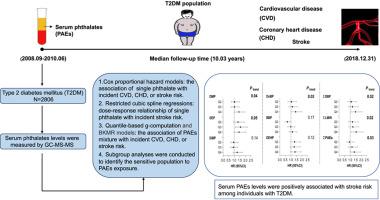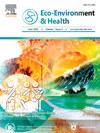在一项前瞻性队列研究中,2型糖尿病患者血清邻苯二甲酸酯和心血管疾病发生的风险
IF 17.6
引用次数: 0
摘要
目前迫切需要关于邻苯二甲酸酯(PAEs)与2型糖尿病(T2DM)人群心血管疾病(CVD)风险之间关系的前瞻性流行病学证据。根据东风-同济队列研究(2008-2010)的基线,共招募2806名T2DM患者,随访至2018年。血清邻苯二甲酸二丁酯(DnBP)、Σdibutyl邻苯二甲酸酯(ΣDBP)和Σlow-molecular-weight邻苯二甲酸酯(ΣLMW)水平与卒中发生风险相关,无论它们的水平是否被视为连续变量[比差(95%CI)分别为1.36(1.02,1.80)、1.35(1.01,1.81)和1.50(1.07,2.10)]或按四分位数划分[比差(95%CI):Cox比例风险模型经多重调整后最高四分位数分别为1.41(1.01,1.98)、1.48(1.05,2.08)、1.53 (1.08,2.15),Ptrend分别为0.03、0.02、0.02。同时,通过限制三次样条回归分析,证明了血清邻苯二甲酸二异丁酯(DiBP)、DnBP、ΣDBP和ΣLMW与卒中发生风险呈线性相关,以及血清邻苯二甲酸丁酯(BBP)与卒中发生风险呈非线性u型剂量反应相关。此外,基于分位数的g计算发现PAE混合物与卒中发生风险呈正相关[HR (95%CI): 1.24(1.05, 1.46)]。然而,血清PAEs,无论是作为个体还是作为混合物,都与心血管疾病或冠心病的发生风险无关。我们的研究表明,血清PAEs与T2DM人群卒中发生风险增加呈正相关。需要更多的前瞻性队列和机制研究来验证我们的发现。本文章由计算机程序翻译,如有差异,请以英文原文为准。

Serum phthalates and risks of incident cardiovascular disease among individuals with type 2 diabetes in a prospective cohort study
Prospective epidemiological evidence about the associations between phthalates (PAEs) and incident cardiovascular disease (CVD) risk among type 2 diabetes mellitus (T2DM) population has been urgently needed. A total of 2806 participants with T2DM were recruited based on the baseline of the Dongfeng-Tongji cohort study (2008–2010) and followed up to 2018. Serum di-n-butyl phthalate (DnBP), Σdibutyl phthalate (ΣDBP), and Σlow-molecular-weight phthalate (ΣLMW) levels were associated with incident stroke risk, whether their levels were treated as continuous variables [HR (95%CI): 1.36 (1.02, 1.80), 1.35 (1.01, 1.81), and 1.50 (1.07, 2.10), respectively] or divided by quartiles [HR (95%CI): 1.41 (1.01, 1.98), 1.48 (1.05, 2.08), and 1.53 (1.08, 2.15) in the highest quartile with Ptrend = 0.03, 0.02, and 0.02, respectively] after multiple adjustment in Cox proportional hazard models. Meanwhile, linear associations for serum di-iso-butyl phthalate (DiBP), DnBP, ΣDBP, and ΣLMW, and a nonlinear U-shaped dose–response association for serum butyl-benzyl phthalate (BBP) with incident stroke risk were proved by restricted cubic spline regression analyses. Furthermore, a positive correlation between PAE mixture and incident stroke risk was identified in Quantile-based g-computation [HR (95%CI): 1.24 (1.05, 1.46)]. However, serum PAEs, either as individuals or as a mixture, were not associated with incident CVD or coronary heart disease risk. Our study revealed that serum PAEs were positively associated with increased incident stroke risk in the T2DM population. More prospective cohort and mechanism studies are warranted to validate our findings.
求助全文
通过发布文献求助,成功后即可免费获取论文全文。
去求助
来源期刊

Eco-Environment & Health
环境科学与生态学-生态、环境与健康
CiteScore
11.00
自引率
0.00%
发文量
18
审稿时长
22 days
期刊介绍:
Eco-Environment & Health (EEH) is an international and multidisciplinary peer-reviewed journal designed for publications on the frontiers of the ecology, environment and health as well as their related disciplines. EEH focuses on the concept of “One Health” to promote green and sustainable development, dealing with the interactions among ecology, environment and health, and the underlying mechanisms and interventions. Our mission is to be one of the most important flagship journals in the field of environmental health.
Scopes
EEH covers a variety of research areas, including but not limited to ecology and biodiversity conservation, environmental behaviors and bioprocesses of emerging contaminants, human exposure and health effects, and evaluation, management and regulation of environmental risks. The key topics of EEH include:
1) Ecology and Biodiversity Conservation
Biodiversity
Ecological restoration
Ecological safety
Protected area
2) Environmental and Biological Fate of Emerging Contaminants
Environmental behaviors
Environmental processes
Environmental microbiology
3) Human Exposure and Health Effects
Environmental toxicology
Environmental epidemiology
Environmental health risk
Food safety
4) Evaluation, Management and Regulation of Environmental Risks
Chemical safety
Environmental policy
Health policy
Health economics
Environmental remediation
 求助内容:
求助内容: 应助结果提醒方式:
应助结果提醒方式:


